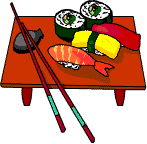The Reluctant Gaijin in Japan: Eating Out and In
Created | Updated Feb 3, 2010

So here I am. Owing to a set of circumstances largely beyond my control, I find myself living and working in Japan. I could tell you the circumstances, give reasons or excuses, but telling you isn't going to help. Let's face it, life – and other four letter words – happen.
Part Three: Eating Out and In
Refreshed from my break, I head back to the reality of my Japanese life. Holidays are not generous in Japan, so it'll be a while before I get that kind of break again. Besides, being waited on hand and foot by Japanese hosts is all very well, but I really ought to learn to fend for myself... shouldn't I?
Food, however, is a bit of a problem. Britain is not well known for its gastronomy and I am not much of one for the culinary arts, being a British male. Friends and relatives who happen upon these words will gasp at the audacity of such an understatement, for I am Mr Fussy. When catering for myself in the UK – I cannot really call it cooking – my diet primarily consisted of cereal, bread, cheese, potatoes, meat, coffee, cola and beer. Oh, and chocolate.
Amazingly, however, I tried almost everything my good hosts put in front of me. This included a range of vegetables for which there is no English equivalent, the obligatory sushi (just a try, mind, not a plateful), jellyfish, which visually I mistook for grated carrot, and whole squid. Less surprisingly, there is very little that I'm planning to add to my regular diet.
In a way, though, my usual diet is not the biggest problem, at least not in itself. Most of my staple foods are available in Japan, but getting them yields a variety of problems. Eating out is not as difficult as one might imagine, as it's not all sushi restaurants and noodle bars. There are plenty of 'family restaurants', reasonably priced and populated by young families and (well-behaved) teenagers; these offer a range of Japanese dishes, burger meals and often steaks or pasta. Ordering is not impossible either, as most places have photographs of the food on the menus and sometimes some English writing. The arrival of the food might throw up one or two surprises, though. Everybody's food doesn't always arrive together and on my first such outing my dining companion began without me, leaving me to forlornly enquire, "Where's mine?" Quantities may surprise – potatoes will be small in size and number and runner beans can be counted on the fingers. Also, that steak you ordered from the picture may turn out to have a Japanese sauce you just weren't expecting.
Supermarkets yield similar dangers. Potatoes, bread and cereal, being eaten in small quantities here, are expensive, although not prohibitively so. That picture of a cow could mean milk, yoghurt, butter, cheese or possibly something beef-flavoured. Of course, often there is no picture or, worse, looks can be deceptive. Vinegar ice cream, anyone? Okay, how about a doughnut? Imagine your reaction as your first bite reveals the filling to be not jam, but fish curry. For those with a sweet tooth like myself, life can be full of little disappointments in a country where tea and red bean are both common flavours for sweets. Tea actually comes in a number of often bitter Japanese varieties and finding 'English Breakfast Tea' took a couple of weeks. The Japanese are big fish eaters, both raw and cooked, and some fish are meant for cooking and others aren't. Never fear, I still cooked the sushi fish I inadvertently bought and it was pretty good. I'm guessing the other way round might not be such a good idea. You're not likely to accidentally buy whale, though. No-one in Japan actually eats whale nor, officialdom apart, cares whether they can hunt it or not. You might get shark, though...
Once you've got your food home, there may be other problems. Even opening a sweet wrapper can be a challenge, as the fiendish packaging often won't open in the manner you'd expect. Still, after a few sweets have gone missing in action under a cupboard or you are wearing your breakfast, you'll get the hang of it. Inside, be wary of silicon gel, even inside individual wrappers, to combat the destructive humidity; also beware decorative plastic that can be mistaken for food (and sometimes tastes better). Now all you've got to do is open the oven and cook your meal. Hmm, no oven. Even in the house I stayed in with four bedrooms, where the lady of the house nary left the kitchen, no oven. Okay, all you've got to do is hack the chicken into bits thin enough to fit under the grill, which will be operated by the button cunningly disguised with a fish symbol and voila - dinner.
Okay, I admit defeat. I reluctantly accept the need to eat rice and fish. 'Taco', which in this country means octopus balls, and natto, which appears to be alien slime, are not on the menu, however.
The Reluctant Gaijin in Japan Archive
